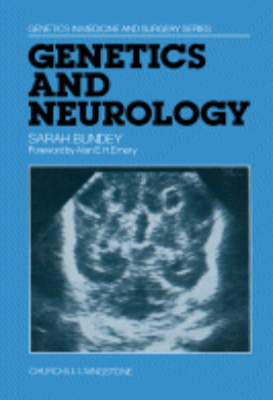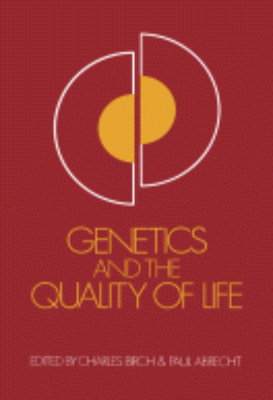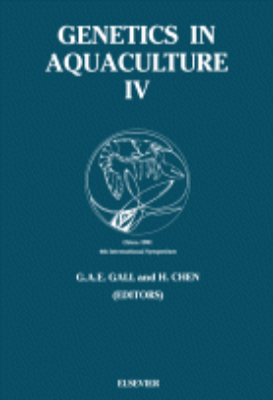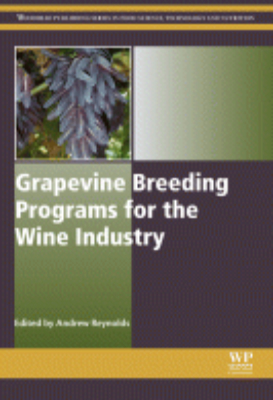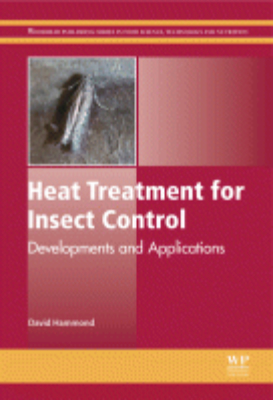Life Science
Genetics and Neurology
Genetics and Neurology focuses on disorders that affect the nervous system, including atrophies, neuropathies, and tumors. The book first examines malformations of the central nervous system, phacomatoses and tumors, and cerebral degenerative disorders of childhood. Topics include malformations of the corpus callosum and neighboring structures; abnormalities of closure of neural tube; spongiform leucodystrophy; and tumors of the nervous system. The text then takes a look at extrapyramidal disorders and dyskinesias and muscle disorders. The publication elaborates on spinal muscular atrophies (SMAs), cerebellar and spinocerebellar ataxias, and hereditary neuropathies. Discussions focus on hereditary motor and sensory neuropathies of infancy and early childhood; peripheral neuropathies and lipid disorders; and congenital cerebellar ataxias. The book also discusses spastic paraplegias and multifactorial inheritance and neurological diseases. The text is a valuable reference for readers interested in genetics and neurology.
Genetics and the Behavior of Domestic Animals
"Behavior is shaped by both genetics and experience--nature and nurture. This book synthesizes research from behavioral genetics and animal and veterinary science, bridging the gap between these fields. The objective is to show that principles of behavioral genetics have practical applications to agricultural and companion animals. The continuing domestication of animals is a complex process whose myriad impacts on animal behavior are commonly under-appreciated. Genetic factors play a significant role in both species-specific behaviors and behavioral differences exhibited by individuals in the same species. Leading authorities explore the impact of increased intensities of selection on domestic animal behavior. Rodents, cattle, pigs, sheep, horses, herding and guard dogs, and poultry are all included in these discussions of genetics and behavior, making this book useful to veterinarians, livestock producers, laboratory animal researchers and technicians, animal trainers and breeders, and any researcher interested in animal behavior. Key Features. Includes four new chapters on dog and fox behavior, pig behavior, the effects of domestication and horse behavior. Synthesizes research from behavioral genetics, animal science, and veterinary literature. Broaches fields of behavior genetics and behavioral research. Includes practical applications of principles discovered by behavioral genetics researchers. Covers many species ranging from pigs, dogs, foxes, rodents, cattle, horses, and cats"
Genetics and the Quality of Life
Genetics and the Quality of Life covers the papers and report of a consultation on Genetics and the Quality of Life, held in Zurich on June 25-29, 1973, organized by the sub-unit on Church and Society of the World Council of Churches in cooperation with the Christian Medical Commission. The book focuses on the interrelation of genetics and quality of life. The selection first elaborates on genetics and moral responsibility and ethics and the new biology. Discussions focus on breakdown of values, genetically determined debility versus socially determined debility, ethical problems, and genetic inequality and moral responsibility. The text then examines ethical issues raised by eugenics, judging the social values of scientific advances, ethical problems raised by genetics, and problems raised by eugenics in Africa. Topics include the right to an adequate physical and mental endowment, genetic engineering, euphenics, constraints imposed by genetics, fertilization of human ova in vitro, and ethical questions in eugenics. The manuscript reviews findings on genetics and the quality of life, sociogenetic problems and public opinion, social and ethical problems in caring for genetically handicapped children, ethical problems in genetic counselling, and psychological issues in counselling the genetically handicapped. The selection is a dependable source of information for researchers interested in the connection of genetics and quality of life.
Genetics Environment and Behavior
Genetics, Environment, and Behavior: Implications for Educational Policy is a collection of papers from the "Genetic Endowment and Environment in the Determination of Behavior" workshop in New York in October 1971. The book discusses the relationships between genetic characteristics and behavior as being significant in understanding human behavior and learning. The text also considers the different approaches made by geneticists and psychologists on this subject. Several papers review, in terms of both quantitative and qualitative analysis, the role that genetics and the environment play in determining behavior. One paper explains the possible role of genetic determination in behaviors as found in mice and men that show high probabilities of heritabilities. Another paper tackles biochemical genetics and explains the evolution of human behavior by addressing the enzyme variations in human brains and the role of language and culture. The book also cites gene-environment interactions and the variability that can be found in behavior with references to the works of Ginsburg (1967) and Vale and Vale (1969). One paper comments on the future of human behavior genetics, highlighting the distinction between what should happen and what most probably will happen. This text is suitable for sociologists, behavioral scientists, geneticists, educators, and students in psychology, psychiatry, and related branches of medicine.
Genetics for Cat Breeders
Genetics for Cat Breeders, Second Edition covers the considerable advances in the practical application of genetics to cat breeding. This book is divided into nine chapters and begins with a discussion of the elementary principles of heredity. The subsequent chapters deal with the practical aspects of feline reproduction and development and the main factors in the practice of cat breeding. Other chapters examine the genetics of feline color and coat variation and breeds. These topics are followed by a review on the problem of genetic defects in cats. The last chapters considers the importance of record keeping in animal breeding, including providing an accurate record of familial relationship, information upon the phenotype characteristics and breeding performance, and a source of data for future decisions. This book will be of great value to biologists, cat breeders, and researchers.
Genetics in Aquaculture
This volume, the proceedings of the Fourth International Symposium on Genetics in Aquaculture, builds on the foundations laid down at the first symposium, held in Galway, Ireland in 1982 (Aquaculture, Volume 33), as well as those laid down at the second, held in Davis, California, USA in 1985 (Genetics in Aquaculture II), and the third, held in Trondheim, Norway in 1988 (Genetics in Aquaculture III). It addresses specific problems and developments in this field, demonstrating the tremendous breadth of research activity as well as the complexity of issues in aquaculture genetics. This book will be of great value to aquaculturists, fisheries scientists and marine biologists. (The above-mentioned proceedings of the first three conferences are still available).
Genetics of Bacterial Diversity
While other texts in this area deal almost solely with the "workhorse strain" Escherischia coli, Genetics of Bacterial Diversity is the first to deal with genetics and molecular biology of the wide range of other bacteria, which carry out a whole spectrum of important scientific, medical, agricultural, and biotechnological activities. Taking genetic diversity as its theme it illustrates a range of interesting phenomena such as genetic systems controlling pathogenicity, symbiosis, chemotaxis, metabolic characteristics, and differentiation. With each chapter written by acknowledged experts, this definitive book contains up-to-the-minute information on this rapidly developing field.Written by leading experts, this text--aimed at graduate-level students and above--describes the genetics and molecular biology of a wide range of bacteria.
Genetics of Bacterial Diversity: 1989
Genetics of Bacterial Diversity focuses on the rapidly developing field of ""non-K-12"" bacterial genetics that is largely outside the scope of other texts. The book begins with an introductory chapter that outlines the phylogenetic relationships of bacteria and the range of metabolic, behavioral, and developmental phenomena displayed by them. Two chapters then review the genetic processes found in bacteria generally, and discuss a range of genetic techniques used to analyze the various special systems described in the body of the book, respectively. Subsequent chapters deal with various special metabolic capabilities characteristic of certain groups of bacteria (light production, photosynthesis, nitrogen fixation, antibiotic production, degradation of aromatic compounds and mercury resistance); developmental processes of cell-cycle associated motility, sporulation, and specialized colonial behavior; four components of bacterial pathogenicity for animals; and pathogenic and symbiotic interactions of bacteria with higher plants. The final chapter explains some of the concepts and the progress being made in the application of population genetics to bacteria. This book may be of interest to microbiologists wishing to catch up on the genetic basis of some of the classical phenomena of bacteriology, and geneticists unfamiliar with some of the things that bacteria can accomplish.
Genetics of Bone Biology and Skeletal Disease
This book identifies and analyzes the genetic basis of bone disorders in humans and demonstrates the utility of mouse models in furthering the knowledge of mechanisms and evaluations of treatments. The book is aimed at all students of bone biology and genetics, and with this in mind, it includes general introductory chapters on genetics and bone biology and more specific disease-orientated chapters, which comprehensively summarize the clinical, genetic, molecular genetic, animal model, functional and molecular pathology, diagnostic, counselling and treatment aspects of each disorder.
Genetics of Movement Disorders
Hereditary or genetic diseases featuring involuntary movements constitute a major aspect of the practice of neurology, functional neurosurgery, genetics, and many areas of basic and applied neuroscience research. Describing the current knowledge on these disorders, Genetics of Movement Disorders brings together information essential for clinicians, geneticists, and neuroscientists in one source. Utilizing a convenient and accessible format, the book is designed to allow easy identification of relevant information, with the overall organization of topics following established phenotypic classifications of movement disorders such as Parkinsonian syndromes, chorea, ataxia, and major categories of diseases grouped by gene locus. This book broadly appeals to neurologists, neuroscientists, geneticists, as well as cell and molecular biologists and hematologists.
Genetics of Reproduction in Sheep
Genetics of Reproduction in Sheep is a compilation of papers that are concerned with the study and application of genetics to the reproduction in sheep. The book is divided into six parts, grouping the papers according to topic. The main topics include genetic variation and selection; the inheritance and the effects of the Booroola gene; genetic strategies for single genes; physiology of genetic variation; the physiological criteria of genetic merit; and the national requirement and systems of husbandry. The text is recommended for those involved with raising sheep and plan to apply genetics in their reproduction, as well as for geneticists who wish to conduct studies on how their field is applied to sheep reproduction.
Genetics of Sex Differentiation
Genetics of Sex Differentiation intends to help readers understand the genetic basis of sex differentiation. The book focuses on explaining how the sex chromosomes affect the process of sex differentiation by influencing the rates at which cells divide. The book is composed of seven chapters. It provides overviews of classical genetics and structure of cells. It also explains the chromosomal basis of sex determination and sex determination using Drosophila. Polygenetics and continuous and quasicontinuous variations are also discussed. The book also discusses sex factors, determination, and disorders. Moreover, it explains the heterochromatin, embryological basis of sex differentiation, and triploidy and autosomal effects. In addition, it discusses the relationship of genes, chromosomes, growth, and sex. The book is an excellent ""bedside book"" for students in biology, specifically in genetics and developmental biology. Lecturers and professionals in biology and genetics will also find this book invaluable for their practice.
Genetics of the Norway Rat
Genetics of the Norway Rat details the various genetic traits of Norway rat. The book covers a wide spectrum of trait inheritance, from color variation up to the various genetic mutation and quirks. The coverage of the text includes growth, metabolism, reproduction, and endocrinology. Several chapters also cover the physiological traits that include skeleton, viscera, sensory organs, and nervous. The text also takes into consideration the immunogenetics, pharmacogenetics, psychogenetics, and cytogenetics of the species studied. The book will be of great interest to mammalian geneticists. Researchers who are using rats as a test subject in their research will also benefit from the text.
Genetics Structure and Function of Blood Cells
Genetics, Structure and Function of Blood Cells contains the proceedings of the symposia of the 28th International Congress of Physiology held in Budapest between 13 and 19 of July, 1980. Organized into six parts, this book begins with a discussion on the genetic regulation of hemoglobin synthesis. Parts II and III describe the immunoglobulin receptors and their effectors, and antenatal development of human blood cells. Subsequent parts talk about regulation of differentiation of hemoglobin structure and function and the role of calcium in red cell membrane transport processes. The last part elucidates the structure and function of blood cell membranes.
Grapevine Breeding Programs for the Wine Industry
"Grapevine Breeding Programs for the Wine Industry: Traditional and Molecular Techniques summarizes recent trends in grapevine breeding, both in terms of research and practical programs. The first group of chapters covers the challenges faced by breeders and existing and emerging techniques used to combat them. Two further groups of chapters focus on grapevine breeding programs in different wine-producing countries around the world. With authoritative contributions from experts across the worlds winemaking regions, this book will be an essential reference for all those involved in viticulture and oeneology wanting to explore new methods, understand different approaches and refine existing practices. Key Features. Covers challenges faced by breeders. Highlights grapevine breeding programs in different wine-producing countries. Contributions from experts across the worlds winemaking regions"
Guide to Biochemistry
Guide to Biochemistry provides a comprehensive account of the essential aspects of biochemistry. This book discusses a variety of topics, including biological molecules, enzymes, amino acids, nucleic acids, and eukaryotic cellular organizations. Organized into 19 chapters, this book begins with an overview of the construction of macromolecules from building-block molecules. This text then discusses the strengths of some weak acids and bases and explains the interaction of acids and bases involving the transfer of a proton from an acid to a base. Other chapters consider the effectiveness of enzymes, which can be appreciated through the comparison of spontaneous chemical reactions and enzyme-catalyzed reactions. This book discusses as well structure and function of lipids. The final chapter deals with the importance and applications of gene cloning in the fundamental biological research, which lies in the preparation of DNA fragments containing a specific gene. This book is a valuable resource for biochemists and students.
Handbook of Epigenetics
Epigenetics is considered by many to be the "new genetics" because of the overwhelming evidence of the contribution of non-genetic factors such as nutrition, environment, and chemical exposure on gene expression. The effects of epigenetics are vast, including tissue/organ regeneration, X-chromosome inactivation, and stem cell differentiation and genomic imprinting and aging. Aberrations of epigenetics influence many diseases for which clinical intervention is already in place, and many novel epigenetic therapies for cancer, immune disorders, neurological and metabolic disorders, and imprinting diseases are on the horizon. This comprehensive collection of reviews written by leaders in the field of epigenetics provides a broad view of this important and evolving topic. From molecular mechanisms and epigenetic technology to discoveries in human disease and clinical epigenetics, the nature and applications of the science will be presented for those with interests ranging from the fundamental basis of epigenetics to therapeutic interventions for epigenetic-based disorders.
Handbook of Genetics and Genomics in Clinical Neurpsychiatry
This foundational work comprehensively examines the current state of the genetics, genomics and brain circuitry of psychiatric and neurological disorders. It consolidates discoveries of specific genes and genomic regions associated with these conditions, the genetic and anatomic architecture of these syndromes, and addresses how recent advances in genomics are leading to a reappraisal of the biology underlying clinical neuroscience. In doing so, it critically examines the promise and limitations of these discoveries toward treatment, and to the interdisciplinary nature of understanding brain and behavior. Coverage includes new discoveries regarding autism, epilepsy, intellectual disability, dementias, movement disorders, language impairment, disorders of attention, schizophrenia, and bipolar disorder. Genomics, Circuits, and Pathways in Clinical Neuropsychiatry focuses on key concepts, challenges, findings, and methods in genetics, genomics, molecular pathways, brain circuitry, and related neurobiology of neurologic and psychiatric disorders.
Heat Treatment For Insect Control
"Stored product insects and other pests represent a major hygiene and safety issue to many industries, from food production to building infestation, and issues for timber pallets and packaging. Beds bugs are rapidly becoming a public health issue in hotels, hostels and houses in many parts of the world. While fumigation has been one of the prevalent routes for pest control, there remain issues with the toxicity of the chemicals used and potential exposure to humans therefore heat treatment has proven to be a successful alternative when used correctly. It is well known that excessive heat is dangerous to life. There is a difference between the amount of heat required to kill microbes such as bacteria and viruses and that required to kill larger life forms such as insects or mammals. This book focuses on the use of heat to kill insects and mites in food production, storage and other facilities. Heat Treatment for Insect Control examines how controlled heat treatment kills all stages of pest insect life across species and without causing damage to surrounding structures or electronics. The advantages of heat treatment include no health & safety hazards, a completely controllable and environmentally friendly process, reduced treatment time of fumigation (hours verses days), as well as no factory shutdown or exclusion of staff from adjacent areas during treatment. Part I reviews the principles of heat treatment, with chapters covering the fundamentals, planning, best practice and costs of integrated pest management. Part II looks at heat treatment applications in food production, storage, food materials and fresh produce. Part III examines the other applications in clothing, small rooms, buildings, and transportation. Key Features. Provides a comprehensive and systematic reference on the heat treatment for insect control. Reviews the development of heat treatment processes and technology as part of integrated pest management approaches"
Hormonal Steroids Biochemistry Pharmacology and Therapeutics
Hormonal Steroids: Biochemistry, Pharmacology, and Therapeutics, Volume I focuses on various research on steroids and their biological and medical involvements. Comprised of 60 chapters, the book presents the literature of various authors who have conducted research on the relationship between hormonal steroids and biochemistry, pharmacology, and therapeutics. The discussions start with the identification of steroids with hormone-like activities. This discussion includes the nature, compositions, properties, possible uses, and reactions of these hormones when exposed to different conditions and controlled environments. The book then proceeds with discussions on synthesis and metabolism of hormonal steroids. These discussions are supported by graphical representations, reviews, recommendations, and methodologies. The book then explains the control of synthesis and release of steroid hormones. This part notes the relationship of renal and adrenal hormones; the control and production of corticosterone; neurosecretion and control of the pituitary gland; and release of ovulating hormones. The book also highlights the mechanism of steroid action, noting the probable interrelationships of steroids, nonsteroids, intermediary metabolism, and inflammation. Various research are presented on the possible clinical applications of steroids. The text is a vital reference for readers who are interested in the study of hormones.
Human Cytogenetics
Human Cytogenetics: Clinical Cytogenetics, Volume II presents the general theoretical principles and clinical aspects of cytogenetics, a branch of genetics that deals specifically with the study of the chromosomes. The volume focuses on the clinical cytogenetics of human. It discusses the sex chromosomes and their abnormalities and the abnormalities of sexual development and differentiation; mechanism of sex determination in mammals; major autosomal abnormalities found in human populations; and chromosome abnormalities in relation to human pregnancy wastage and chromosome changes in neoplasia. The book will be a great reference book for geneticists, cytogeneticists, pathologists, clinicians, and medical students.

